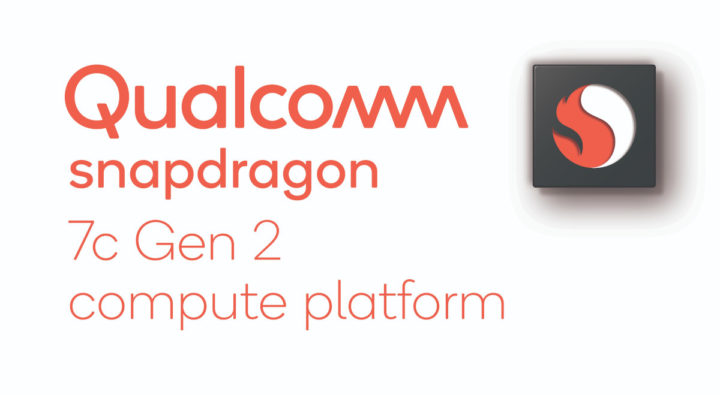Qualcomm’s Snapdragon 7c Gen 2 SoC for entry-level laptops and Chromebooks follows the steps of the Snapdragon 7c processor with a slightly higher frequency for the Kryo 468 cores, leading to a 6% performance improvements.
As we’ll see below, most of the specifications are exactly the same, except the built-in Snapdragon X15 LTE modem is now listed as supporting LTE Cat 14 up to 600 Mbps, instead of LTE Cat 15 up to 800 Mbps, and UFS downgraded to UFS 2.1 from UFS 3.0.

- CPU – Octa-core Kryo 468 (Cortex-A76) processor up to 2.55 GHz
- GPU – Unnamed Qualcomm Adreno GPU (Note: Snapdragon 7c had Qualcomm Adreno 618 GPU)
- DSP – Qualcomm Hexagon 692 DSP
- Memory – 2x 16-bit LPDDR4x-4266
- Storage – eMMC 5.1, UFS 2.1
- Display
- On-device display up to QXGA (2048 x 1536) @ 60 Hz
- External display up to QHD (2560×1440) @ 60 Hz
- Video Playback – Up to 4K HDR10 with H.265 (HEVC), H.264 (AVC), VP9 codecs
- Camera
- Image Signal Processor: Qualcomm Spectra 255 ISP, 14-bit
- 4x MIPI CSI PHYs (DPHY 1.2 / CPHY 1.2)
- Dual Camera, ZSL, 30fps: Up to 16 MP
- Single Camera, ZSL, 30fps: Up to 32 MP
- Camera Features
- Multi-Frame Noise Reduction (MFNR) and Multi-Frame Super Resolution (MFSR)
- Forward-looking Electronic Image Stabilization (EIS)
- Motion Compensated Temporal Filtering (MCTF) for noise-free video capture up to UHD (4K) at 30 FPS
- Video Capture Features: Rec. 2020 color gamut video capture, Up to 10-bit color depth video capture
- Audio
- Qualcomm Aqstic audio codec, Qualcomm Aqstic smart speaker amplifier
- Qualcomm aptX, aptX HD audio playback support
- PCM playback up to 384kHz/32bit
- Native DSD support
- Connectivity
- Snapdragon X15 LTE modem
- LTE Category – Downlink: Cat 12, uplink: Cat 13
- Downlink
- 3×20 MHz carrier aggregation
- LTE MIMO: Up to 4×4 MIMO on two carriers
- QAM: Up to 256-QAM, Up to 64-QAM
- 600 Mbps max
- Uplink
- Snapdragon Upload+
- 2×20 MHz carrier aggregation
- Up to 64-QAM
- Wi-Fi
- Dual-band 802.11ac Wave 2 WiFi 5, 802.11a/b/g, 802.11n
- Qualcomm FastConnect Subsystem
- MIMO Configuration: 2×2 (2-stream)
- Bluetooth 5.0
- GPS Location – Satellite Systems Support: NavIC, BeiDou,
Galileo, GLONASS, GPS, QZSS, SBAS
- Snapdragon X15 LTE modem
- Security
- Qualcomm Processor Security
- Qualcomm Content Protection
- Wi-Fi Security: WPA3
- Process Technology – 8 nm
Snapdragon 7c Gen 2 supports both Windows 10 & ChromeOS. It feels more like a relaunch with potentially some cost-cutting measures rather an upgrade to Snapdragon 7c.
Qualcomm still says the Gen 2 compute platforms deliver up to 10% higher system performance than competitive platforms with up to 19+ hours of continuous use on a single charge is up to 2x the battery life of typical entry-tier laptops, compared to Intel-based laptops.
The first Windows 10 Arm laptops and Chromebooks are expected later this summer. More details may be found on the product page.

Jean-Luc started CNX Software in 2010 as a part-time endeavor, before quitting his job as a software engineering manager, and starting to write daily news, and reviews full time later in 2011.
Support CNX Software! Donate via cryptocurrencies, become a Patron on Patreon, or purchase goods on Amazon or Aliexpress





I see 4K video decoding, but I dont see 4K HDMI. That means that the laptop will always need upscaling when connected to a 4K TV/4K monitor.
RK3399 and RPi4 already support 4K HDMI.
That just tells you the specs were coppied over from a phone SoC where the display will not be 4K, but people want 4K cameras. The 4K playback is just so that you can review videos you have captured.
Don’t think of this in the context of desktops, but rather as a rebadged phone SoC.
One problem of the Windows ARM laptops was price, wan’t it? About 800 USD for a laptop, with as pro’s “longer battery” and “always online”. And one big elephant in the room.
Anwyay: has the price problem been solved? An ARM laptop for 350 USD would be more interesting. Otherwise I’ll stick to my i3.
What’s the point of downgrading UFS3.0 to UFS2.1?
I’m confused as well, unless it can help cut costs somehow. Another possibility is inaccuracies in the specs either for Gen2 or for the first Snapdragon 7c.